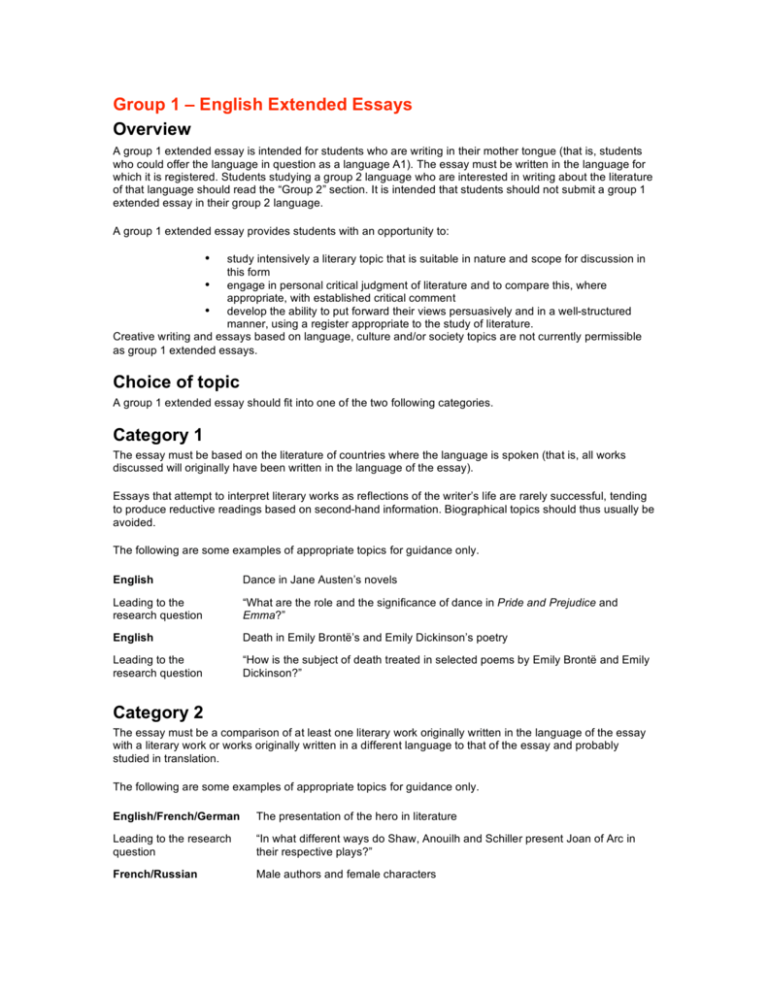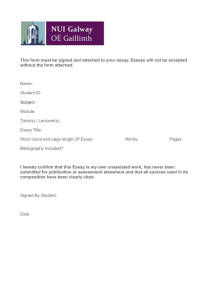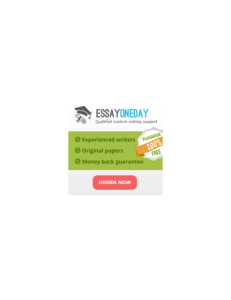English Extended Essays Overview
advertisement

Group 1 – English Extended Essays Overview A group 1 extended essay is intended for students who are writing in their mother tongue (that is, students who could offer the language in question as a language A1). The essay must be written in the language for which it is registered. Students studying a group 2 language who are interested in writing about the literature of that language should read the “Group 2” section. It is intended that students should not submit a group 1 extended essay in their group 2 language. A group 1 extended essay provides students with an opportunity to: study intensively a literary topic that is suitable in nature and scope for discussion in this form • engage in personal critical judgment of literature and to compare this, where appropriate, with established critical comment • develop the ability to put forward their views persuasively and in a well-structured manner, using a register appropriate to the study of literature. Creative writing and essays based on language, culture and/or society topics are not currently permissible as group 1 extended essays. • Choice of topic A group 1 extended essay should fit into one of the two following categories. Category 1 The essay must be based on the literature of countries where the language is spoken (that is, all works discussed will originally have been written in the language of the essay). Essays that attempt to interpret literary works as reflections of the writer’s life are rarely successful, tending to produce reductive readings based on second-hand information. Biographical topics should thus usually be avoided. The following are some examples of appropriate topics for guidance only. English Dance in Jane Austen’s novels Leading to the research question “What are the role and the significance of dance in Pride and Prejudice and Emma?” English Death in Emily Brontë’s and Emily Dickinson’s poetry Leading to the research question “How is the subject of death treated in selected poems by Emily Brontë and Emily Dickinson?” Category 2 The essay must be a comparison of at least one literary work originally written in the language of the essay with a literary work or works originally written in a different language to that of the essay and probably studied in translation. The following are some examples of appropriate topics for guidance only. English/French/German The presentation of the hero in literature Leading to the research question “In what different ways do Shaw, Anouilh and Schiller present Joan of Arc in their respective plays?” French/Russian Male authors and female characters Leading to the research question “In what ways do the male authors of Anna Karenina and Madame Bovary seek to render their heroines sympathetic to the reader? How far do they succeed?” Italian/English The use of literary tradition Leading to the research question “Themes and stylistic devices from Dante in TS Eliot’s The Waste Land and Four Quartets.” The topic chosen must be literary in nature and could be about a particular aspect, or be a comparative study, of a work or works, author, period or genre. The extended essay may relate to work studied in class but students must take care in all cases to demonstrate relevant wider reading and individual study. Appropriate literary works may be chosen from any source; students need not restrict themselves to works on the IB prescribed book list (PBL) for the language of the essay. The following examples of titles for group 1 extended essays are intended as guidance only. The pairings illustrate that focused topics (indicated by the first title) should be encouraged rather than broad topics (indicated by the second title). English: “Religious imagery in Wuthering Heights” is better than “Religion in the Brontës”. English: “A comparison of the presentation of racial conflict in one work by James Baldwin and one work by Richard Wright” is better than “Racial conflict in the works of American writers”. French: “The portrayal of women in the works of Zola” is better than “The works of Zola”. French: “Existentialism in Les Mains Sales and Les Mouches by Sartre” is better than “What is existentialism?”. Spanish: “The treatment of social conflict in La Busca by Pío Baroja” is better than “Social conflict in modern literature”. Treatment of the topic Literary works often address, for example, philosophical, political or social questions. However, the major focus of the essay should be the literary treatment of such questions. The literary works should not be a pretext for interdisciplinary study and should not be treated simply as documentary evidence in a discussion of philosophical, political or social issues. Students should always consider how the texts work as literature, dealing with aspects such as the effects they achieve, the devices they use and the way they are written. Students should not use the extended essay solely as a vehicle for their own thoughts but, after providing careful analysis of the author’s ideas, should present their personal views on the way the author has treated the subject. There should be a compromise between building on the wisdom of more experienced critics and introducing new personal elements. The mere reiteration of the views of established literary critics will not result in a successful extended essay. When writing the essay, students must bear in mind that any narrative and/or descriptive material included should be directly relevant to the critical analysis. A precis of the student’s reading is not sufficient. Tab - Interpreting the assessment criteria Criterion A: research question Although the aim of the essay can best be defined in the form of a question, it may also be presented as a statement or proposition for discussion. A research question that is too narrow or too obvious will normally be deemed to be one that does not lend itself to systematic investigation in an extended essay. Criterion B: introduction The context should be established succinctly and should not be an excuse for padding out an essay with a lengthy account of the historical or biographical context of a literary text. Instead, the introduction should focus on the research question and the student’s reasons for choosing it. In some cases, students may be able to say how it relates to existing knowledge on the topic but, since they cannot be expected to know the whole range of secondary writing on major texts, it is sufficient for them to state briefly why they have chosen their particular research question and what they think it has to offer. Criterion C: investigation The range of resources includes, in the first place, the primary texts being studied (and, possibly, other writings by the author(s) in question, such as essays, journals and letters) and, less importantly, secondary sources such as published criticism on those texts. The proper planning of an essay should involve interrogating secondary sources in light of the research question, so that the views of critics are used to support the student’s own argument, and not as a substitute for that argument. It may thus be helpful for a student to challenge a statement by a critic instead of simply agreeing with it. In a literary context, the data gathered is principally the evidence the student finds in the primary text(s) to support the argument of the essay. If students make use of Internet-based sources, they should do so critically and circumspectly in full awareness of their potential unreliability. Criterion D: knowledge and understanding of the topic studied The topic studied here is principally the primary text(s) that is/are the focus of the essay. The quality of the student’s understanding of the primary text(s) is the main concern. The use of secondary sources is not an essential requirement: this may be helpful in the case of classic texts, enabling discussion to start at a higher level, but it should not replace the student’s personal engagement with the primary text(s). Criterion E: reasoned argument Students should be aware of the need to give their essays the backbone of a developing argument. Personal views should not simply be stated but need to be supported by reasoned argument to persuade the reader of their validity. Straightforward description of a literary text through plot summary or narration of the action does not usually advance an argument and should generally be avoided (although, where a littleknown text is under discussion, a brief description may be appropriate). Criterion F: application of analytical and evaluative skills appropriate to the subject Appropriate application of analytical and evaluative skills here is the use of persuasive analysis and argument to support a personal interpretation. Second-hand interpretations that are derived solely from secondary sources will lose marks under this criterion, as will purely descriptive essays that list examples of literary motifs but fail to analyse them. Criterion G: use of language appropriate to the subject There is no single acceptable style for essays, which may be well-written in different ways—with, for example, different degrees of personal emphasis, some writers using the first person and others preferring a more impersonal mode of expression. Clarity and precision of communication in a group 1 essay includes the correct use of language. Criterion H: conclusion “Consistent” is the key word here: the conclusion should develop out of the argument and not introduce new or extraneous matter. It should not repeat the material of the introduction; rather, it should present a new synthesis in light of the discussion. Criterion I: formal presentation This criterion refers to the extent to which the essay conforms to academic standards about the way in which research papers should be presented. The presentation of essays that omit a bibliography or do not give references/citations for quotations is deemed unacceptable (level 0). Essays that omit one of the required elements—title page, table of contents, page numbers—are deemed no better than satisfactory (maximum level 2), while essays that omit two of them are deemed poor at best (maximum level 1). Criterion J: abstract The abstract is judged on the clarity with which it presents the three required elements, not on the quality of the research question itself, nor on the quality of the argument or the conclusions. Criterion K: holistic judgment This criterion allows examiners to reward work that shows initiative, creativity and insight, even if the essay does not achieve the highest standard overall. Routine essays on well-worn topics will not score highly under this criterion.







